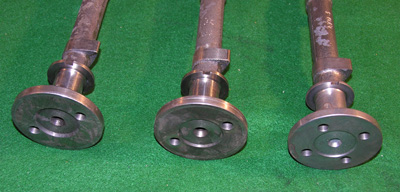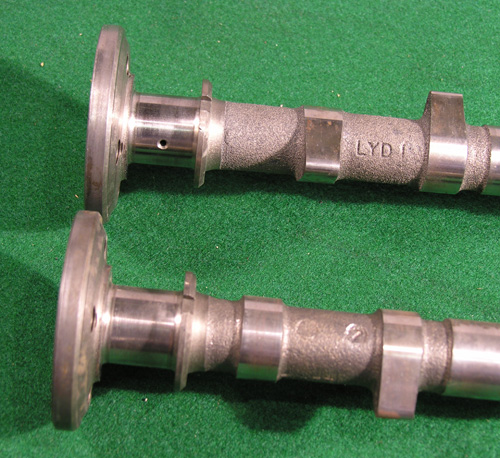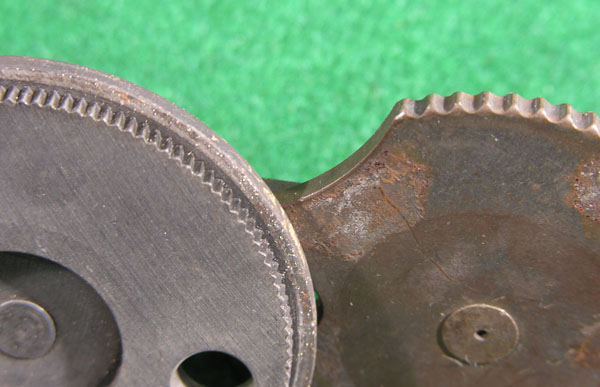
Left: Series 1 XKE Exhaust cam
Center: 1968 intermediate cam (note
groove around front flange)
Right: Later Series 2 cam

Pair of V12 camshafts. Note length to first lobes. These are right and left as installed in engine.
Camshafts
As far a camshafts are concerned, the Series 1 XKE’s used the same camshafts whether 3.8 or 4.2. They were identified by the front mounting to the chain drive by two bolts. These also have oil holes drilled in the bottom of the lobes. The standard valve adjustment is specified as .004" on the intake side and .006" on the exhaust side. If you are adjusting them and cannot get them right on the specs, it is better to error on the wide side. High performance use specifies up to .010". For street use, this just makes a lot of noise. This camshaft is pictured on the left side of the picture below. All three of the cams are exhaust side cams. When the timing mark is at the top, the first or front lobe points to the side of the engine it goes on.
In 1968, Jaguar changed the lobe pattern of the camshafts. This was not an emission change but rather a change to smooth out the tappet noise. The lobe engaged the tappet more gently rather than slapping. These cams are identified by the two bolt front and a groove cut around the front flange. This cam is in the middle of the picture below. These cams adjust .012-.014". This is the same adjustment for intake or exhaust. I have found that adjusting them towards the higher end gives a much smoother idle without a noticeable noise increase.
Shortly after these cams were introduced, Jaguar changed to a 4 bolt design and dropped the groove around the front flange. The lobe design remained the same and continued until the end of the Series 3 XJ6’s in 1987. The oil holes on the lobes were dropped when the cams were changed to 4 bolt. Since the tappets are splash fed, there is adequate oil held in the top of the head for lubrication. These cams can be installed in the earlier engines for a quieter running engine with no noticeable loss of power or smoothness. Just make sure that the adjustment is correct for the camshafts, not the year car.
The V12 cams are almost all the same. The first 5000 engines had a different part number listed but from there on, the cams seem to be the same. The XKE V12 had valve clearances of .014-.016. The same cams went into the XJ12 and XJS with specs of .012-.014. From there they went into the HE engines with clearances of .010-.012. As on the later 6 cylinder cars, adjusting on the wide side helps smooth out the idle and engine vacuum.
The V12 cams are hard to mix up as they are different lengths. However, to make it easy, the right side camshaft has the front two lobes pointing upwards when the timing mark is upright. Camshaft in right picture on top is the right side cam. I have had the best luck on the V12 engines with valve adjustment of .013-.014. This keeps the engine quiet and peppy.
Left: Series 1 XKE Exhaust cam Center: 1968 intermediate cam (note Right: Later Series 2 cam |
Pair of V12 camshafts. Note length to first lobes. These are right and left as installed in engine. |
|---|---|
Not to be left out, the drive sprockets for the camshafts vary from year to year. Although this has nothing to do with adjustment, I thought identifying them would be helpful. On the left is a early drive sprocket. It is used from the early XK120's into the Series 1 XKE's. The Second from the left is identical but has a rod instead of a nut and threaded shaft. Both are two hole and the bolts used have a cross hole drilled in them so as to use lock wire to secure them. The Middle one is the one to watch out
 |
 |
|---|
for as it does not have as many teeth and the teeth it has are spaced wider so have even less tooth to tooth contact. The picture on the right shows this very clearly. I have not been able to trace out a number for this from the Jaguar parts book. It seems to show up in the 1969 model year engines. Jaguar stopped using it after a very brief time and went to the four bolt configuration. If you have the scalloped 2 bolt ones on your engine, throw them away and replace them with the round ones. The four bolt ones will work with the two bolt cams and the two bolt ones will work with the 4 bolt cams.
The four bolt sprockets use plates under the bolts that bend up to lock the bolts to keep them from turning. These bolts are not cross drilled but the cross drilled ones will work as the size and thread are the same. The sprocket on the far right is out of a V12 engine. Only difference is the length of the stud being shorter. This part is also used in the later XJ40 and X300 Sedan.
Next comes the issue of Performance camshafts. Very rarely will installing a set of "HOT" camshafts improve performance without also doing some modifications to the engine. Generally, hotter camshafts help the engine breathe better by holding the valves open longer or opening them further than stock. If the engine has excess breathing capabilities, then the cams should help performance. The V12 engine is one that does not benefit from performance cams without serious modifications to the inlet and exhaust breathing of the engine. The cam and valve size are well matched to the size of the inlet manifolds. Opening up the ports and manifolds help a lot but even then, it is hard to do better than stock cams on the V12 unless a lot of other modifications have been done first. The six cylinder engine can benefit from the hotter cams with little more than different carburetor needles for mixture control.
There are now portable tools for measuring mixture on running cars that are not that expensive. I have found that on the triple carb XKE's, the recommended needles for performance cams are the UO needles. (Stock are UM ) A lot of times, these needles are far to rich at full load. Bottom line is to check before you change things. Sometimes you need to modify the needles yourself to match the rev and load ranges as needed.
There are two basic ways of making performance cams. The first way requires grinding the camshaft for a different shape lobe. For extreme increases in lobe and duration, new castings are required. These are usually made out of billet steel which is very strong. They can end up with an increased lift, duration, or both. Duration is the opening period that the valve is lifted off of the seat. Increasing lift alone can increase performance without a lot of side effects. Increasing duration on the other hand can lower idle vacuum making the idle unstable. This is because of what is referred to as overlap. That is when the inlet and exhaust valves are open at the same time. There is some overlap on a stock engine. As the engine goes up in the rev range, overlap is less of an issue and increased duration helps the engine to breathe better. Increased duration also moves the power band of the engine up the rev range. By moving up the range, the lower end usually loses some of it's off the line power. To get the most from increased duration cams, increased compression is usually needed. Larger valves and ports also help.
Higher lift cams will also require spring clearance checking. Coil bind can occur which is when the coil is compressed to the point where the coils actually hit each other. To fix this requires machining of the spring base on the head. Not all heads can handle this. Also, larger lobes may require larger tappets which will require machining of the tappet guides and replacement of the tappets. Oversize shims are usually required to get the cams into proper clearance adjustment.
Mixture control is another issue. Most cars already are designed to run a little on the rich side at full throttle so this should not present a problem.There are now portable tools for measuring mixture on running cars that are not that expensive. I have found that on the triple carb XKE's, the recommended needles for performance cams are the UO needles. (Stock are UM ) A lot of times, these needles are far to rich at full load. Bottom line is to check before you change things. Sometimes you need to modify the needles yourself to match the rev and load ranges as needed
Please note that all of the recommendations are for the Jaguar Engines and based on my personal experience. There are always exceptions. If you have any experiences that help confirm or clarify issues, I would love to hear from you. Properly installing and setting up a set of performance cams can bring excellent results if the end goal is matched with the changes necessary to achieve it.